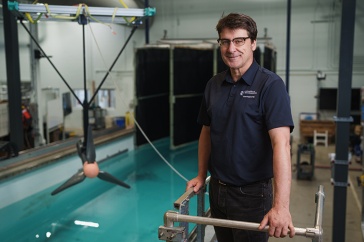
As the COVID-19 pandemic has taken hold over the past several months, causing shutdowns and altered schedules, more and more people have found themselves with time to devote to outdoor recreation. The upside? More exercise, enjoying nature and perhaps picking up some new, long-term healthy habits. The downside? The explosion in numbers of people visiting public parks and protected areas has caused concern among resource managers that increasing visitation may be contributing to overcrowding and an overall negative outdoor recreation experience – or worse, permanently displacing visitors altogether.
Assistant professor in the department of recreation management and policy Michael Ferguson, along with colleagues Lauren Ferguson and Robert Barcelona, undertook a study over the summer to further investigate this phenomenon, specifically in New Hampshire’s White Mountain National Forest (WMNF), which covers more than 750,000 acres of land and has more than 1,200 miles of hiking trails. The study, funded by the USDA Forest Service, also involved the work of two student research assistants who distributed surveys to residents of 10 towns that surround the WMNF.
"Natural resource managers must now confront the daunting task of managing this massive influx of visitation to parks and proteced areas while simultaneously providing high-quality outdoor recreation experiences."
The results will help inform resource managers as they strive to provide high-quality outdoor recreation experiences on the WMNF during these challenging times.
Georgia Giles ‘G21 and Courtney Barrows ’21 thought they would be conducting face-to-face survey interviews over the summer as part of the study, but the pandemic thwarted that. So instead, the research team quickly transitioned the study methods; they developed and implemented an innovative ‘knock and drop’ survey methodology which entailed hand distributing 3,000 survey kits and another 3,000 survey reminder postcards within residential neighborhoods surrounding the WMNF.
“I can’t emphasize enough how hard Georgia and Courtney worked,” says Ferguson. “Not only did they put every survey kit together, but they walked upwards of 8 miles each day in full PPE to deliver them.”
For Giles, whose work on the WMNF study is part of her master’s thesis, the most interesting part of the project was having the chance to talk with people, albeit briefly, when dropping off surveys. “It was great to interact with residents and see how much they truly care about the forest and the resource,” she says. “A lot of people wanted to talk about their experiences.”
  |
Participants had the option of completing the survey online or mailing a hard copy via a prepaid return envelope. Though the results have not been fully analyzed yet, a higher than average response rate for a study of this nature was achieved, says Ferguson, which further points to the hard work and dedication by Giles and Barrows as well as the level of concern and interest people have for the WMNF.
“The COVID-19 global pandemic has created a unique scenario for outdoor recreation visitors and natural resource managers,” says Ferguson. “Suddenly, visitors have found abundant free time to participate in their favorite outdoor recreation activities. On the flip side of that coin, natural resource managers must now confront the daunting task of managing this massive influx of visitation to parks and protected areas while simultaneously providing high-quality outdoor recreation experiences.”
Barrows, who graduates in December with her undergraduate degree in recreation management and policy, grew up in North Conway so participating in the study for her summer internship was a natural fit. “Being from that area, I have a personal connection to the forest, so I knew it would be fun and interesting to be involved with the study,” she says.
Barrows also worked with Ferguson on the larger WMNF National Visitor Use Monitoring Program (supported by the USDA Forest Service) over the summer, so she was already in the WMNF as part of that project. “I was visiting many different sites in the forest and I don’t think there was a single day when they weren’t all packed. There were a lot of people. Everyone I talked to just wanted to be outside because they had been so cooped up.”
The WMNF displacement study is one component of the larger WMNF National Visitor Use Monitoring Program study assessing the overall visitation on the WMNF that will be completed this winter. In addition to other outcomes, these two studies will quantify the overall increase in visitation on the WMNF during the COVID-19 pandemic and provide WMNF resource managers with the data they need to make informed decisions related to visitor preferences, behaviors and optimal recreation use levels and experiences.
-
Written By:
Callie Carr | UNH College of Health and Human Services | callie.carr@unh.edu | 603-862-0970

















































